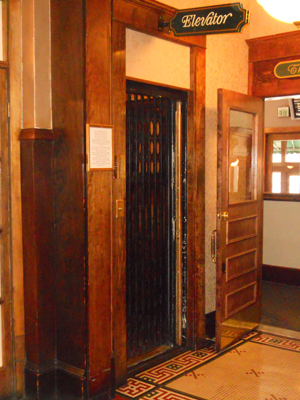
- The Boulderado Hotel in Colorado has a century-old elevator (shown here) with a Twitter account of recent vintage. While its Tweets come from a mischievous bell staff, many other newer machines have built-in software and hardware that allows them to communicate information.
I’m a bit of tech buff (although not as much as my colleague, WAHVE COO Frank Sentner, who can make computers work better just by talking with users very gently over the telephone. You might call him “The Computer Whisperer.”) My iPad2 is well worn and I can keep up with my grandchildren over the Internet with the best of the Grandmoms out there, if I say so myself.
But we seniors are just beginning to use the web to connect. And it’s not only people that will connect, it’s things. A recent article in Forbes magazine “How The Internet of Things Will Change Almost Everything” delivered this statistic:
“Today, there are roughly two Internet-connected devices for every man, woman and child on the planet. By 2025, analysts are forecasting that this ratio will rise past six.”
Those statistics for today include the millions of run-of-the-mill smartphones and book readers in just about everybody’s hands. For the future, the growth will come as devices like cars, appliances, and home security and utility systems get connected. As boomers age, they’ll be on the leading edge of this technology (and not just from devices like “Life Alerts” and other safety devices for the infirmed that use the invisible communications spectrum to connect one machine to another).
I went to a meeting in 2012 in an old hotel (Hotel Boulderado) where the circa-1906 elevator has its own Twitter account. Legend has it a bored bell captain came up with the idea and created the account. Talk about the old and the new.
In 1999, when the Internet was really just starting to hum, Kevin Ashton coined the phrase “the Internet of Things” to explain that machine-to-machine interactions could aid humans who were beginning to face much greater demands on their mental attention. Ashton cofounded the Auto-ID Center at the Massachusetts Institute of Technology, which created a global standard system for RFID and other sensors.
Ashton predicted human benefits from having the things in the physical world connected to the Internet via sensors:
“If we had computers that knew everything there was to know about things—using data they gathered without any help from us—we would be able to track and count everything, and greatly reduce waste, loss and cost. We would know when things needed replacing, repairing or recalling, and whether they were fresh or past their best. The Internet of Things has the potential to change the world, just as the Internet did. Maybe even more so.”
Since devices can connect to each other online—and people can connect with each other online—we’ve got the perfect environment for people to connect to work online.
What have you got connected?
— Sharon Emek, Ph.D.
Founder and CEO
WAHVE












0 Comments